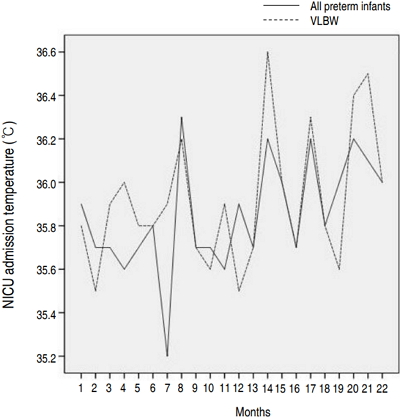- Original Article
- Neonatology (Perinatology)
- The impact of a quality improvement effort in reducing admission hypothermia in preterm infants following delivery
-
Han Saem Choi, Soon Min Lee, Hoseon Eun, Minsoo Park, Kook-In Park, Ran Namgung
-
Clin Exp Pediatr. 2018;61(8):239-244. Published online August 15, 2018
-

|
Purpose: Hypothermia at admission is associated with increased mortality and morbidity in preterm infants. We performed a quality improvement (QI) effort to determine the impact of a decrease in admission hypothermia in preterm infants.
Methods: The study enrolled very low birth weight (VLBW) infants born at Gangnam Severance Hospital between January 2013 and December 2016. This multidisciplinary QI effort included the... |
-
-
- Postdischarge growth assessment in very low birth weight infants
-
Joon-Sik Park, Jungho Han, Jeong Eun Shin, Soon Min Lee, Ho Seon Eun, Min-Soo Park, Kook-In Park, Ran Namgung
-
Clin Exp Pediatr. 2017;60(3):64-69. Published online March 27, 2017
-
|
|
Purpose The goal of nutritional support for very-low-birth-weight (VLBW) infants from birth to term is to match the in utero growth rates; however, this is rarely achieved. MethodsWe evaluated postdischarge growth patterns and growth failure in 81 Korean VLBW infants through a retrospective study. Weight and height were measured and calculated based on age percentile distribution every 3 months until age 24... |
-
-
- Clinical Studies of Metabolic Bone Disease of Prematurity
-
Seung-Yeon Suh, Eun-Kyung Lee, Ran Namgung, Hae-Jung Joo, Min-Soo Park, Kook-In Park, Chul Lee, Dong-Gwan Han, Meung-Jun Kim, Jin-Suk Suh
-
Clin Exp Pediatr. 1995;38(2):159-169. Published online February 15, 1995
-
|
|
Purpose : Preterm formula used in Korea, theoretically does not supply the recommended mineral intake for optimal bone metabolism in very low birth weight infants(Formula 500-700 mg Ca/L, 300~370mg P/L, and 440IU of vitamin D/L). The purpose of this study is to identify th e possible etiologic factors and clinical course of rickets in these infants.
Methods : We recently identified... |
-
-
|













